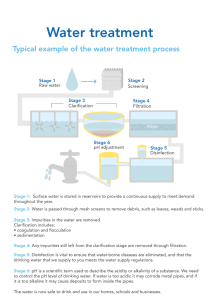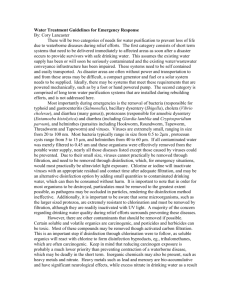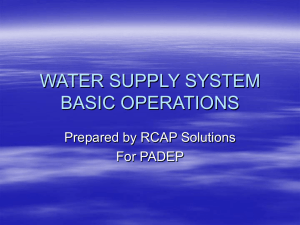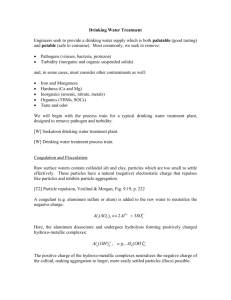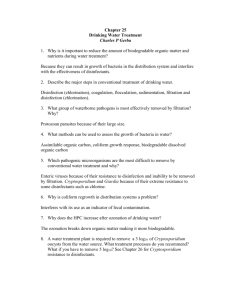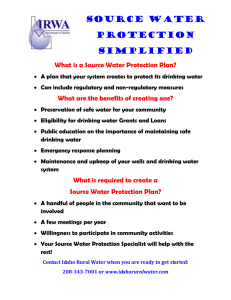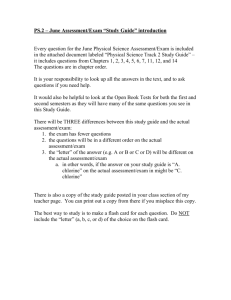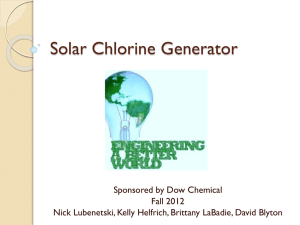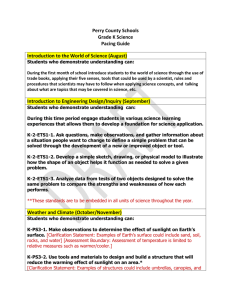Global Water Experiment - American Chemical Society
advertisement
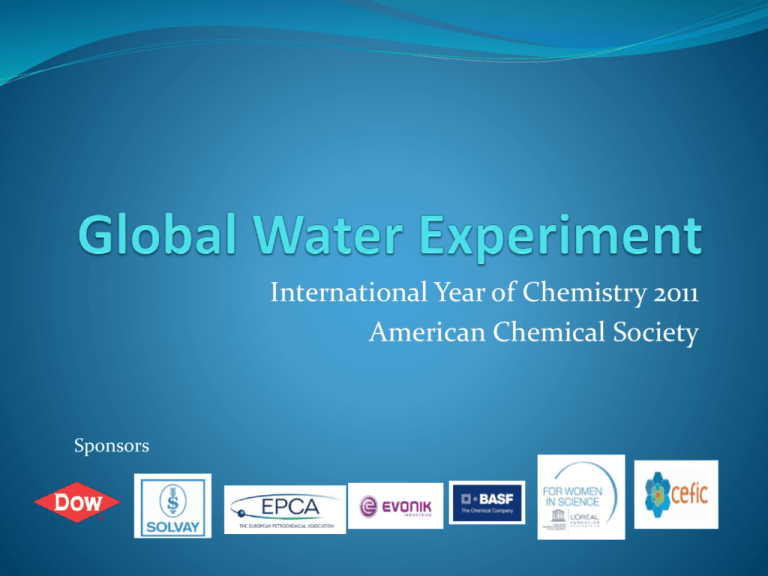
International Year of Chemistry 2011 American Chemical Society Sponsors Live Webcast with NASA – September 22, 2011 @ 10:00am ACS and NASA partnered to launch a live webcast on NASA’s Digital Learning Network (DLN). Pacific High school was selected along with 2 other schools in the United States to participate in a live webcast, with ACS and NASA scientists (located at Johnson Space Center) who explained and answer questions related to water purification processes, the IYC global water experiment, and water purification on NASA’s International Space Station. Lab – Water: No Dirt, No Germs Possibly the biggest chemistry experiment ever. Purpose To raise awareness of the critical use of chemistry to provide one of the most basic human needs - Safe, Clean Drinking water. Research This lab will explore the role water has in society and the environment. Water: No Dirt, No Germs Use household materials to build a water filtration unit and identify the efficiently of different filtration materials Background By 1911, water treatment was becoming common in Europe and North America. Waterborne disease In developing countries 4 out of 5 illness are caused by waterborne diseases. 1.1 billion people still lack access to improved drinking water. 2,213,000 deaths annually. Natural Disasters After Tsunami in 2004 and Japan in 2010 and Hurricanes like Katrina, there is always large increase in water bourn diseases such as cholera, Hepatitis A, Typhoid fever, Malaria, and Dengue Fever. Waterborne disease Waterborne diseases such as typhoid fever and cholera are still around, killing thousands of people each year, even though chemical technology tools for clean water are available. Number of cases of waterborne disease Waterborne disease in USA Transmission of disease through water Eliminating Waterborne Disease With simple household materials, water can be filtered and disinfected to produce clean safe drinking water for the world, virtually eliminating waterborne disease. Lab – No Dirt, No Germs This lab will replicate two main steps of drinking water treatment: 1. 2. Clarification Disinfection Clarification To remove solid debris from natural or waste water Involves four steps: 1. Aeration 2. Coagulation 3. Sedimentation 4. Filtration Clarification – Step 1: Aeration Aeration: adds air to water Allows gases trapped in water to escape. Adds oxygen to the water Clarification – Step 1: Aeration Done by shaking and pouring water back and forth between two containers Clarification – Step 2: Coagulation Coagulation: removes dirt and other floating solid particles by chemically sticking them together in FLOCS (clumps of Alum and sediment). Clarification – Step 2: Coagulation Done by adding ALUM and stirring for 5 minutes Clarification – Step 3: Sedimentation Sedimentation: gravity pulls particles of FLOC to bottom of container. Clear water remains at top and is drained and filtered. Clarification – Step 3: Sedimentation Done by letting ALUM treated water sit for 20 minutes. Clarification: Step 4 - Filtration Filtration: sand and pebble filter removes most impurities that remain in the water Filtration Unit Clarification: Step 4 - Filtration Done by pouring the top ¾ of the untreated water into a filter and collecting the treated water. Disinfection Disinfection: Drinking water chlorination A small amount of chlorine is added to large volumes of drinking water. Destroys germs (Bacteria & Viruses). Disinfection Done by adding enough chlorine (bleach) to destroy germs, plus a little more to fight new germs that water may encounter before water reaches your home. Extra chlorine is called “chlorine residual” Disinfection Chlorine test strips detect the chlorine residual. Pacifica High School Results Chemistry Club Officers Lab set up Adrian Quezada Nia Ferrer Karina Lopez Yalitzi Guerrero Sonia Mendoza Jeff Borreta David Lai Lab Group 1 Members George Arce III Carolina Espinoza Keziah Valenzuela Anaiancy Ramirez Megan Vey Lab 1 results Water from roadside puddle – Oxnard, Ca Lab Group 2 Members Ky-Cuong Huynh Jackie Loyola Kathleen Callejo Shawn Copon Rita Nobile Krisha Algoso Lab 2 results Lake Water – Mammoth Lake, Ca Lab Group 3: Members Lorena Covarrubias Lupita Delgadillo Inah Ducos Dana Salonga Lab 3 results Pacifica High School Water – Oxnard, Ca Lab Group 4: Members Role Jay Del Castillo Ricardo Vasquez Jose Arias Alex Tapia Jamie Cruz Kenny Wong Our Results Ocean Water – Ventura, Ca Students: Lab Group 5: Members Juan Carranza Jenny Ruedy Angelica Bonilla Jonathan Tran Vanesssa Alvarado Lab 5 Results Ventura Pier, Ca Lab Group 6: Members Daniel Hernandez Daniel Rodriguez Lab 6 Results Creek water – Ojai, Ca Lab Group 7: Members Hector Ramos John Sampang Phillip Lai Lab 7 Results Channel Islands Harbor Lab Group 8: Members Karlo Santiago Sean Ligsay Hannah Licuidine Roland Digma Tino Dondiego Lab 8 Results Sea Bridge Ocean way Special Thanks to: Water Collection – Mr. Carr and Mr. Edwards Technology – Mr. Erik Ward Teacher Support – Mrs. Winter, Mrs. Zehner, Mrs. White, Mr. Sheehy, and Mr. Lee Facilities –Mr. Gurney, Mrs. Beltran, Mr. Hayes, and Pacifica Special Education Department Public Works in Oxnard Water...essential to all life: Past, present and future Our constant goal is to provide you, our customer, with a safe and dependable supply of drinking water. We have provided resources of the Water Section’s services to our residents that may be useful as a customer of the City of Oxnard. Location: 251 South Hayes Ave. Oxnard, CA 93030 Phone: (805) 385-8136 Hours: Monday - Thursday (7:00 a.m. - 6:00 p.m.) Alternate Fridays (7:00 a.m. - 5:00 p.m.)
